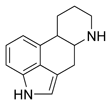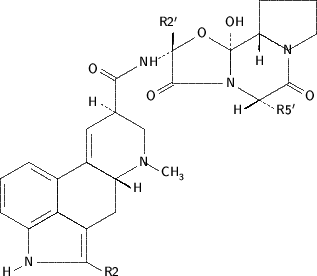Lucas Liaudet, Thierry Buclin, Christian Jaccard, Philippe Eckert, Critical Care Division, Department of Internal Medicine (Service B), University Hospital, 1011 Lausanne, Switzerland
Ergotism is a severe complication of chronic abuse or acute intoxication with ergot derivatives. Occasional cases have been reported in patients taking usual doses of ergot combined with drugs that interact with it.[1 2] We report a case of severe ergotism associated with the anti-HIV drug ritonavir.
A woman aged 28 who was positive for HIV infection was treated with anti-HIV tritherapy: stavudine (40 mg/12 h), didanosine (200 mg/12 h), and ritonavir (600 mg/12 h). She also received fluoxetine (20 mg/24 h) for depressed mood. Five days before admission she had begun to take a combination drug (0.3 mg ergotamine tartrate, 0.2 mg belladonna extract, and 20 mg phenobarbital) twice daily for gastric discomfort. On the day before admission she developed painful sensations in both legs. On admission, her four extremities were pale, cold, and pulseless. A Doppler examination showed diffuse arterial spasms affecting the aorta and the femoral and humeral arteries; distal pulses were absent. Treatment with intravenous sodium nitroprusside, heparin, and morphine was started. Peridural anaesthesia was needed for intractable pain. After 3 days she developed cyanosis and oedema in both legs. Despite the addition of intravenous nifedipine, iloprost, and nitrates, she developed bilateral gangrene of the toes, necessitating transmetatarsal amputation 5 weeks later.
This patient developed severe ergotism after taking 3 mg ergotamine over 5 days, a low dose in terms of the recommended safe dosage of ergot (up to 6 mg a day or 10mg a week during chronic administration). We speculate that an interaction between ritonavir and ergotamine was responsible for this case. Indeed, ritonavir is a potent inhibitor of cytochrome P-450 isoenzymes, mainly CYP3A4,[3] which is responsible for the metabolism of ergot.[1] Thus, ergot concentrations probably increased to toxic amounts in our patient because ritonavir inhibited ergotamine metabolism. Fluoxetine, another inhibitor of cytochromes, might also have played some part by blocking supplementary metabolic pathways. This interaction between ergot derivatives and ritonavir has been described in the technical information provided by the manufacturer,[4] and another case of ergotism has been reported in a patient with AIDS who received both ritonavir and ergotamine.[5]
Doctors should be aware of this harmful interaction, and any administration of ergot alkaloids should be discontinued when ritonavir treatment is started in patients with HIV infection.
[1] Horowitz RS, Dart RC, Gomez HE Clinical ergotism with lingual ischemia induced by clarithromycin-ergotamine interaction. Arch Intern Med 1996;156:456-8.
[2] Bongard O, Bounameaux H. Severe iatrogenic ergotism: incidence and clinical importance. Vasa 1991;20:153-6.
[3] Heylen R, Miller R. Adverse effects and drug interactions of medications commonly used in the treatment of adult HIV positive patients (part 2). Genitourin Med 1997;73:5-11.
[4] Abbott Laboratories. Norvir (technical information). Chicago, IL: Abbott Laboratories, 1997.
[5] Caballero-Granado FJ, Viciana P, Cordero E, Gomez-Vera MJ, del Nozal M, Lopez-Cortes LE Ergotism related to concurrent administration of ergotamine tartrate and ritonavir in an AIDS patient. Antimicrob Agents Chemother 1997;41:1207.
COPYRIGHT 1999 British Medical Association
COPYRIGHT 2000 Gale Group




